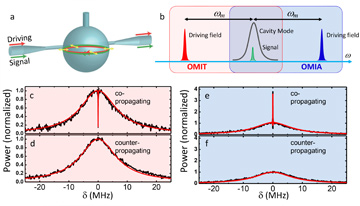 (a) A strong driving field enhances the optomechanical coupling between a vibrational mode and the copropagating optical mode inside a microcavity. (b) Spectral position of the driving and signal fields in OMIT and OMIA processes. (c to f) Non-reciprocal spectra in OMIT and OMIA processes.
(a) A strong driving field enhances the optomechanical coupling between a vibrational mode and the copropagating optical mode inside a microcavity. (b) Spectral position of the driving and signal fields in OMIT and OMIA processes. (c to f) Non-reciprocal spectra in OMIT and OMIA processes.
Non-reciprocal devices such as circulators and isolators, which allow light to pass in a specified direction but block it in an undesired direction, are indispensable to classical and quantum information processing in photonic integrated circuits. But integrating conventional optical non-reciprocal devices, which employ the magneto-optical Faraday effect, is technically challenging because of material incompatibilities and the large footprint of device designs.1 Thus, in recent years, interest has increased in realizing non-reciprocal photonic devices without magnetic materials.
In 2016, we experimentally demonstrated non-magnetic non-reciprocity using optomechanical interactions in a whispering-gallery microresonator,2 as had been proposed several years ago.3 In this approach, the microresonator’s traveling-wave nature produces a rise in the degenerate clockwise (CW) and counterclockwise (CCW) traveling-wave optical modes. The CW and CCW optical modes are independently coupled with the mechanical mode—and only when the optical driving and signal fields are coupled to the same optical mode is coherent conversion enabled between the signal photon and phonon. As a result, the directional driving field breaks the time-reversal symmetry and leads to non-reciprocal transmittance for the signal light.
In a fiber-coupled silica microsphere system, we observed optomechanically induced non-reciprocal transparency (OMIT) and amplification (OMIA), and demonstrated a non-reciprocal phase shift of up to 40 degrees. The non-reciprocal phase shift has fundamental interest for exploring exotic topological photonics, such as the realization of chiral edge states and topological protection.4 In addition, optomechanically induced non-reciprocity can be controlled using two oppositely propagating driving fields that excite the CW and CCW modes simultaneously, which allows conversion of optical fields from the CW mode to the CCW mode. Therefore, the system behaved as a controllable narrowband reflector with non-reciprocal transmittance.
The underlying mechanism of optomechanically induced non-reciprocity can be generalized to any traveling-optical-wave resonator with mechanical vibration. It can be operated with many optical modes in a broad wavelength range and can readily be implemented in current integrated photonic chips. With the mechanical vibrations being cooled to their ground states, applications in the quantum regime, such as single-photon isolators and circulators, also become possible.
Researchers
Zhen Shen, Yan-Lei Zhang, Yuan Chen, Xu-Bo Zou, Fang-Wen Sun, Guang-Can Guo and Chun-Hua Dong, University of Science and Technology of China, Hefei, China
Chang-Ling Zou, University of Science and Technology of China and Yale University, Conn., USA
Yun-Feng Xiao, Peking University, Beijing, China
References
1. L. Bi et al. Nat. Photon. 5, 758 (2011).
2. Z. Shen et al. Nat. Photon. 10, 657 (2016).
3. M. Hafezi et al. Opt. Express 20, 7672 (2012).
4. L. Lu et al. Nat. Photon. 8, 821 (2014).
